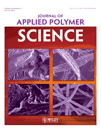Using carbon black nanoparticles to dye the cationic-modified cotton fabrics
Abstract
Carbon black (CB) aqueous dispersion was prepared and used to dye the cationic-modified cotton fabrics through exhaust dyeing process. The effects of CB concentration, CB nanoparticles size, dyeing bath pH, dyeing time and dyeing temperature were investigated. The color yields of dyed fabrics were evaluated on Kubelka-Munk value K/S. The surface morphologies of cationic modified and nonmodified cotton fabrics were measured by video microscope. The fabrics presented 18.9 of the color yield with the dyeing conditions: the dyeing solution contained 2% o.w.f. CB and dyeing at 80°C for 30 min with pH 13 using a 50 : 1 liquor ratio. The images of the video microscope demonstrated a clear surface profile for the cationic-modified cotton fabrics dyed with smaller CB particle size solutions. These results indicated that CB nanoparticles were suitable for dyeing the cotton fabrics. © 2011 Wiley Periodicals, Inc. J Appl Polym Sci, 2011




